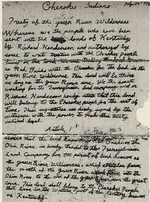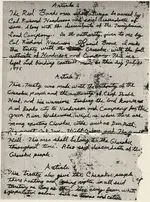Re: Indians of the Swift era... (Trails & Great Shawnee Cave)
Eskippakithiki going back through history
The Shawnee are comprised of five named divisions: Chillicothe, Hathawekela, Kispogogi, Mequachake, and Piqua. Captin John Smith who arrived in the new world in 1607, refered to the "Chawanocks" as living in Virginia, where they continued in dwindling numbers for some years. That the "Chawanocks" were Shawnee is questionable but "Chawanocks" is very similar to "Sawanwake" a plural name for Shawnee. By 1680 the principle locations of the Shawnee were in the Cumberland valley and along the Savannah river in South Carolina. They had migrated either to the mouth of the Ohio and up the Cumberland and Tennessee rivers, or over the Great Warriors Path southward across Kentucky.
The cumberland river was in fact called the Shawnee river up until the end of the 18th century. When the early French traders came into this area in the 1670's the Shawnee had a principle village on the Cumberland river, near the present-site of Nashville, which had been occupied as early as 1665. On a map in 1684 the main river emptying into the Mississippi from the east is the Casquinampogama (Tennessee) and it has several tributarys including the Wabash and Ohio rivers. The westernmost river to flow into the Tennessee is the "Misseoucipi" (not to be confused with the Mississippi river) and the next river is labeled "Skipaki-cipi".
Between these rivers is the Shawnee village of Cisca, with a path leading to Saint Petro on the coast of Florida and a legend that translates "path by which the Shawnee trade with the Spanish". In 1683 the inhabitants of Cisca and other Shawnee's joined the French at Fort Saint Louis on the Illinois river. On this same map the village of "Mequatchaiki" is situated on the north bank of the Skipakicipi river, probally a village of the "Mequachake division. The Skipakicipi river is undoughtably the Green river, but the identity of the "Misseoucipi is not clear, it's probally the Red River or the Licking river.
In 1707 a southern indian taken captive to Virginia drew a map on which he placed a village called "Ephippeck" (Eskippeck) on the Apalachicola river in the panhandle of Florida. This could be a Shawnee settlement from the group identified with the Skipakicipi river in Kentucky and more possablly the group that later returned to build Eskippakithiki in Clark county, Kentucky. The Shawnee group being the Mequachake, or the Piqua. Kentucky historian Lucien Beckner suggest that the village of Eskippakithiki in Clark county may have been originally settled by a party of those fleeing from the Cumberland river, this may have been the group situated on the Apalachicola river in 1707 who moved north settleing first at present-day Nashville and driven from there to Eskippakithiki by 1718.
Eskippakithiki is a Shawnee word meaning "blue lick place". The village was favorably located near preasent day Winchester on a hill above Lulbegrud creek. The site was as the name implies near a saltlick, which attracted large numbers of animals. It was also situated along the Great Warriors Path the major trail leading from villages in Ohio to the Cumberland river and on to the south. Besides Beckners interpretaion there are many other theories about the origin of this village, but there was apparently no white contact there until 1752.
There was some 3,500 acres of land cleared by the Shawnee in the vicinity of Eskippakithiki, baseing estaments on the time required to deaden and completely remove by burning the great oaks, hickories, sycamores, gums, and maples from such an area, Willard Jillson noted Kentucky historian sets the founding of the village at 1680-1685. Such an early date is very possable in that Shawnee groups escaping the Iroquois down the Great Warriors Path would have passed through this area.
Eskipakithiki is an interesting and important village for the Shawnee. According to Beckner it was originally built by a group or groups belonging to the Mequachake or Piqua divisions, and he believes this to be the village listed in the 1736 census of containing some 200 men. It is certain that Eskippakithiki was home of one of the most famous of the Shawnee chiefs, Cathecassa, better known as Black Hoof. Several sources mention him in relation to this village, and Black Hoof himself claimed to have been born there.
In 1752 a Virginia trader named John Finley was invited by the Shawnee to build a house at Eskippakithiki, but he was forced to flee in 1753 when some French Indians attacked a group of Virginia traders at the village. The village was abandoned in 1754 after the fall of Fort Necessity, and the inhabbatants apparently joined the Shawnee in Ohio, though some may have joined the Cherokee in eastern Tennessee...
There may have been a settlement in eastern Kentucky in the period after the French and Indian war. Historian Jillson places a Shawnee village at the confluence of Big Mud Lick and Little Mud Lick creeks in northern Johnson County from 1764 to 1774. This is the village from which Jenny Wiley is supposed to have made her escape. There are other references to the Shawnee in the vicinity of Big Sandy river as well. One of the most interesting accounts is the tradition of John Swift, who is said to have discovered and worked silver mines with the Shawnee as labors in eastern Kentucky from 1760-1770.
This tradition persistes among the Shawnee as late as 1870, when a decendant of Cornstalk returned to Mud Lick creek in Johnson county in search of silver....









